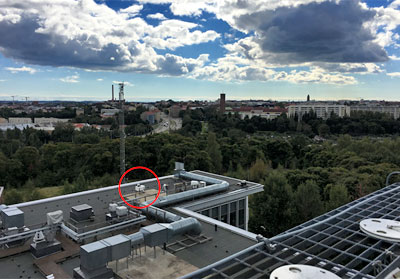|
|
|
| Picture: Roof of the FMI building with main instrument of the project as an example (HALO Doppler Wind Lidar, red circle). |
Finnish Meteorology Institute (FMI)
University of Helsinki, Finland
05/09/2016-09/09/2016
This one week visit at the FMI in Helsinki served as a follow up of Antti Manninen's visit to Cologne in November 2015 and is part of an international co-operation led by Ewan O'Connor of FMI. The project deals with the classification of the cloudy boundary layer and the identification of turbulence processes and their origin based on Doppler wind LIDAR observations.
The main objective for the week was the implementation of a Low Level Jet (LLJ) classification into the already established boundary layer (BL) classification, in order to investigate connections between LLJ and turbulence in the atmospheric BL. The criteria of the LLJ classification, which can be found in Tuononen et al. 2015, consist of an absolute and relative threshold to find local maxima in the wind speed profile. Since the LLJ classification will be applied to several sites including a continental mid-latitude site (FZJ Jülich - JOYCE, Germany) and a high latitude coastal region (Hyytiälä, Finland), differences in the frequency and diurnal/seasonal cycle can be identified when applying the classification to a long term data set.
The turbulent properties in the BL classification are characterized by the dissipation rate of the turbulent kinetic energy calculated from the Doppler velocity standard deviation. This quantity requires an accurate estimate of the contribution from velocity uncertainties, which are directly related to the signal to noise ratio (SNR). Therefore the Doppler LIDAR measurements need to be corrected first for the background noise behavior to allow for a reduction in the SNR threshold to distinguish between noise, cloud and aerosol signals [Manninen et al., 2016]. This step is now decoupled from the BL classification and corrected Doppler LIDAR files are stored to improve the computation time.
In this project we are aiming for several publications, including the methodology and application of the BL classification, statistics of low level jets at several sites, and distinguishing between clouds and aerosols, and clouds and precipitation.
Co-operation partners:
- Ewan O'Connor (FMI)
- Antti Manninen (PhD student at University of Helsinki)
References:
- Tuononen, M., Sinclair, V. A. and Vihma, T. (2015), A climatology of low-level jets in the mid-latitudes and polar regions of the Northern Hemisphere. Atmos. Sci. Lett., 16: 492–499. doi:10.1002/asl.587
- Manninen, A. J., O'Connor, E. J., Vakkari, V., and Petäjä, T.: A generalised background correction algorithm for a Halo Doppler lidar and its application to data from Finland, Atmos. Meas. Tech., 9, 817-827, doi:10.5194/amt-9-817-2016, 2016.
PhD student: Tobias Marke
Institute for Geophysics and Meteorology, University of Cologne
TR32-D2 | Identification of patterns in long-term observations of the cloudy boundary layer











